Characteristics and Causes of Long-Term Water Quality Variation in Lixiahe Abdominal Area, China
Abstract
1. Introduction
2. Materials and Methods
2.1. Study Area Description
2.2. Hydrological and Water Quality Monitoring
2.3. Research Methods
2.3.1. Comprehensive Water Quality Identification Index (CWQI)
2.3.2. Continuous Wavelet Transform
2.3.3. Trend Analysis Methods
2.3.4. Cross Wavelet Transform and Wavelet Coherence
3. Characteristics of Water Quality Variation
3.1. General Description of Water Quality
3.2. Periodic Variation of Water Quality
3.3. Long-Term Trends of Water Quality
4. Possible Causes of Water Quality Variation
4.1. Input of Regional Water Pollutants
4.2. Correlation Analysis of Water Quality and Water Level
4.3. Correlation Analysis of Water Quality and Amount of Diversion Water
5. Conclusions
Author Contributions
Funding
Acknowledgments
Conflicts of Interest
References
- Zhai, X.Y.; Xia, J.; Zhang, Y.Y. Integrated approach of hydrological and water quality dynamic simulation for anthropogenic disturbance assessment in the Huai River Basin, China. Sci. Total Environ. 2017, 598, 749–764. [Google Scholar] [CrossRef] [PubMed]
- Hussein, H. The Guarani Aquifer System, highly present but not high profile: A hydropolitical analysis of transboundary groundwater governance. Environ. Sci. Policy. 2018, 83, 54–62. [Google Scholar] [CrossRef]
- Odeh, T.; Mohammad, A.H.; Hussein, H.; Ismail, M.; Almomani, T. Over-pumping of groundwater in Irbid governorate, northern Jordan: A conceptual model to analyze the effects of urbanization and agricultural activities on groundwater levels and salinity. Environ. Earth Sci. 2019, 78, 40. [Google Scholar] [CrossRef]
- Mohammad, A.H.; Jung, H.C.; Odeh, T.; Bhuiyan, C.; Hussein, H. Understanding the impact of droughts in the Yarmouk Basin, Jordan: Monitoring droughts through meteorological and hydrological drought indices. Arab. J. Geosci. 2018, 11, 103. [Google Scholar] [CrossRef]
- Cullaj, A.; Hasko, A.; Miho, A.; Schanz, F.; Brandl, H.; Bachofen, R. The quality of Albanian natural waters and the human impact. Environ. Int. 2005, 31, 133–146. [Google Scholar] [CrossRef]
- Bordalo, A.A.; Teixeira, R.; Wiebe, W.J. A water quality index applied to an international shared river basin: The case of the Douro River. Environ. Manag. 2006, 38, 910–920. [Google Scholar] [CrossRef]
- Xu, Z.-X. Single factor water quality indentification index for environmental quality assessment of surface water. J. Tongji Univ. (Nat. Sci.) 2005, 33, 321–325, (In Chinese with English abstract). [Google Scholar]
- Lermontov, A.; Yokoyama, L.; Lermontov, M.; Machado, M.A.S. River quality analysis using fuzzy water quality index: Ribeira do Iguape river watershed, Brazil. Ecol. Indic. 2009, 9, 1188–1197. [Google Scholar] [CrossRef]
- Zhang, Y.; Guo, F.; Meng, W.; Wang, X.-Q. Water quality assessment and source identification of Daliao river basin using multivariate statistical methods. Environ. Monit. Assess. 2009, 152, 105–121. [Google Scholar] [CrossRef]
- Hurley, T.; Sadiq, R.; Mazumder, A. Adaptation and evaluation of the Canadian Council of Ministers of the Environment Water Quality Index (CCME WQI) for use as an effective tool to characterize drinking source water quality. Water Res. 2012, 46, 3544–3552. [Google Scholar] [CrossRef]
- Ahmed, S.; Khurshid, S.; Madan, R.; Amarah, B.A.A.; Naushad, M. Water quality assessment of shallow aquifer based on Canadian Council of Ministers of the environment index and its impact on irrigation of Mathura District, Uttar Pradesh. J. King Saud Univ. Sci. 2020, 32, 1218–1225. [Google Scholar] [CrossRef]
- Ajorlo, M.; Abdullah, R.B.; Yusoff, M.K.; Halim, R.A.; Hanif, A.H.M.; Willms, W.D.; Ebrahimian, M. Multivariate statistical techniques for the assessment of seasonal variations in surface water quality of pasture ecosystems. Environ. Monit. Assess. 2013, 185, 8649–8658. [Google Scholar] [CrossRef] [PubMed]
- Sojka, M.; Siepak, M.; Ziola, A.; Frankowski, M.; Murat-Blazejewska, S.; Siepak, J. Application of multivariate statistical techniques to evaluation of water quality in the Mala Welna River (Western Poland). Environ. Monit. Assess. 2008, 147, 159–170. [Google Scholar] [CrossRef] [PubMed]
- Zhou, L.; Xu, S. Application of grey clustering method in eutrophication assessment of wetland. J. Am. Sci. 2006, 2, 53–58. [Google Scholar]
- Wątor, K.; Kmiecik, E.; Lipiec, I. The use of principal component analysis for the assessment of the spatial variability of curative waters from the Busko-Zdrój and Solec-Zdrój region (Poland)–preliminary results. Water Supply 2018, 19, 1137–1143. [Google Scholar] [CrossRef]
- Xia, R.; Chen, Z. Integrated water-quality assessment of the Huai River Basin in China. J. Hydrol. Eng. 2014, 20, 05014018. [Google Scholar] [CrossRef]
- Sarkar, A.; Pandey, P. River water quality modelling using artificial neural network technique. Aquat. Procedia 2015, 4, 1070–1077. [Google Scholar] [CrossRef]
- Hind, J.A.; Marwan, A. Assessing groundwater vulnerability in Azraq Basin area by a modified drastic Index. J. Water Resour. Prot. 2010, 2, 944–951. [Google Scholar]
- Merchant, J.M. GIS-Based groundwater pollution hazard assessment: A critical review of the DRASTIC Model. Photograomm. Eng. Rem. Sens. 1994, 60, 1117–1127. [Google Scholar]
- Torrence, C.; Comopo, G.P. A practical guide to wavelet analysis. Bull. Am. Meteorol. Soc. 1998, 79, 61–78. [Google Scholar] [CrossRef]
- Grinsted, A.; Moore, J.C.; Jevrejeva, S. Application of the cross wavelet transform and wavelet coherence to geophysical time serial. Nonlinear Proc. Geoph. 2004, 11, 505–514. [Google Scholar] [CrossRef]
- Smith, L.C.; Turcotte, D.L.; Isacke, B. Stream flow characterization and feature detection using a discrete wavelet transform. Hydrol. Processes. 1998, 12, 233–249. [Google Scholar] [CrossRef]
- Labat, D. Recent advances in wavelet analyses: Part 1. A review of concepts. J. Hydrol. 2005, 314, 275–288. [Google Scholar] [CrossRef]
- Kang, S.-J.; Lin, H. Wavelet analysis of hydrological and water quality signals in an agricultural watershed. J. Hydrol. 2007, 338, 1–14. [Google Scholar] [CrossRef]
- Hatvani, I.G.; Clement, A.; Korponai, J.; Kern, Z.; Kovács, Z. Periodic signals of climatic variables and water quality in a river-eutrophic pond-wetland cascade ecosystem tracked by wavelet coherence analysis. Ecol. Indic. 2017, 83, 21–31. [Google Scholar] [CrossRef]
- Barzegar, R.; Adamowski, J.; Moghaddam, A.A. Application of wavelet-artificial intelligence hybrid models for water quality prediction a case study in Aji-Chay River. Stoch. Environ. Res. Risk Assess. 2016, 30, 1797–1819. [Google Scholar] [CrossRef]
- Barzegar, R.; Moghaddam, A.A.; Adamowski, J.; Ozga-Zielinski, B. Multi-step water quality forecasting using a boosting ensemble multi-wavelet extreme learning machine model. Stoch. Environ. Res. Risk Assess. 2018, 32, 799–813. [Google Scholar] [CrossRef]
- Parmar, K.S.; Makkhan, S.J.S.; Kaushal, S. Neuro-fuzzy-wavelet hybrid approach to estimate the future trends of river water quality. Neural Comput. Appl. 2019, 31, 8463–8473. [Google Scholar] [CrossRef]
- Najah, A.A.; EI-Shafie, A.; Karim, O.A. Water quality prediction model utilizing integrated wavelet-ANFIS model with cross-validation. Neural Comput. Appl. 2012, 21, 833–841. [Google Scholar] [CrossRef]
- Ghassemi, F.; White, I. Inter-basin Water Transfer: Case Studies from Australia, United States, Canada, China, and India; Cambridge University Press: New York, NY, USA, 2007. [Google Scholar]
- Zeng, Q.H.; Qin, L.H.; Li, X.Y. The potential impact of an inter-basin water transfer project on nutrients (nitrogen and phosphorous) and chlorophyll a of the receiving water system. Sci. Total Environ. 2015, 536, 675–686. [Google Scholar] [CrossRef]
- Hoekstra, A.Y.; Mekonnen, M.M. Imported water risk: The case of the UK. Environ. Res. Lett. 2016, 11. [Google Scholar] [CrossRef]
- Xu, Z.-X. Comprehensive water quality identification index for environmental quality assessment of surface water. J. Tongji Univ. (Nat. Sci.) 2005, 33, 482–488, (In Chinese with English abstract). [Google Scholar]
- GB3838-2002. The State Standards of the People’s Republic of China: Standard for Surface Water Environmental Quality Assessment; China Environmental Science Press: Beijing, China, 2002. (In Chinese) [Google Scholar]
- Liu, F.; Chen, H.; Cai, H.-Y.; Luo, X.-X.; Ou, S.-Y.; Yang, Q.-S. Impacts of ENSO on multi-scale variations in sediment discharge from the Pearl River to the south China sea. Geomorphology 2017, 293, 24–36. [Google Scholar] [CrossRef]
- Gocic, M.; Trajkovic, S. Analysis of changes in meteorological variables using Mann-Kendall and Sen’s slope estimator statistical tests in Serbia. Glob. Planet. Chang. 2013, 100, 172–182. [Google Scholar] [CrossRef]
- Douglas, E.M.; Vogel, R.M.; Kroll, C.N. Trends in floods and low flows in the United States: Impact of spatial correlation. J. Hydrol. 2000, 240, 90–105. [Google Scholar] [CrossRef]
- Tabari, H.; Talaee, P.H. Analysis of trends in temperature data in arid and semi-arid regions of Iran. Glob. Planet. Chang. 2011, 79, 1–10. [Google Scholar] [CrossRef]
- Rahman, A.; Dawood, M. Spatio-statistical analysis of temperature fluctuation using Mann-Kendall and Sen’s slope approach. Clim. Dyn. 2017, 48, 783–797. [Google Scholar] [CrossRef]
- Zhou, J.-N.; Fu, G.S.; An, H.; Jiang, C.J. Analysis of Temporal and spatial variation characteristics of water quality in Lixiahe Abdominal Area. China Rural Water Hydropower 2020, 4, 22–29, (In Chinese with English Abstract). [Google Scholar]
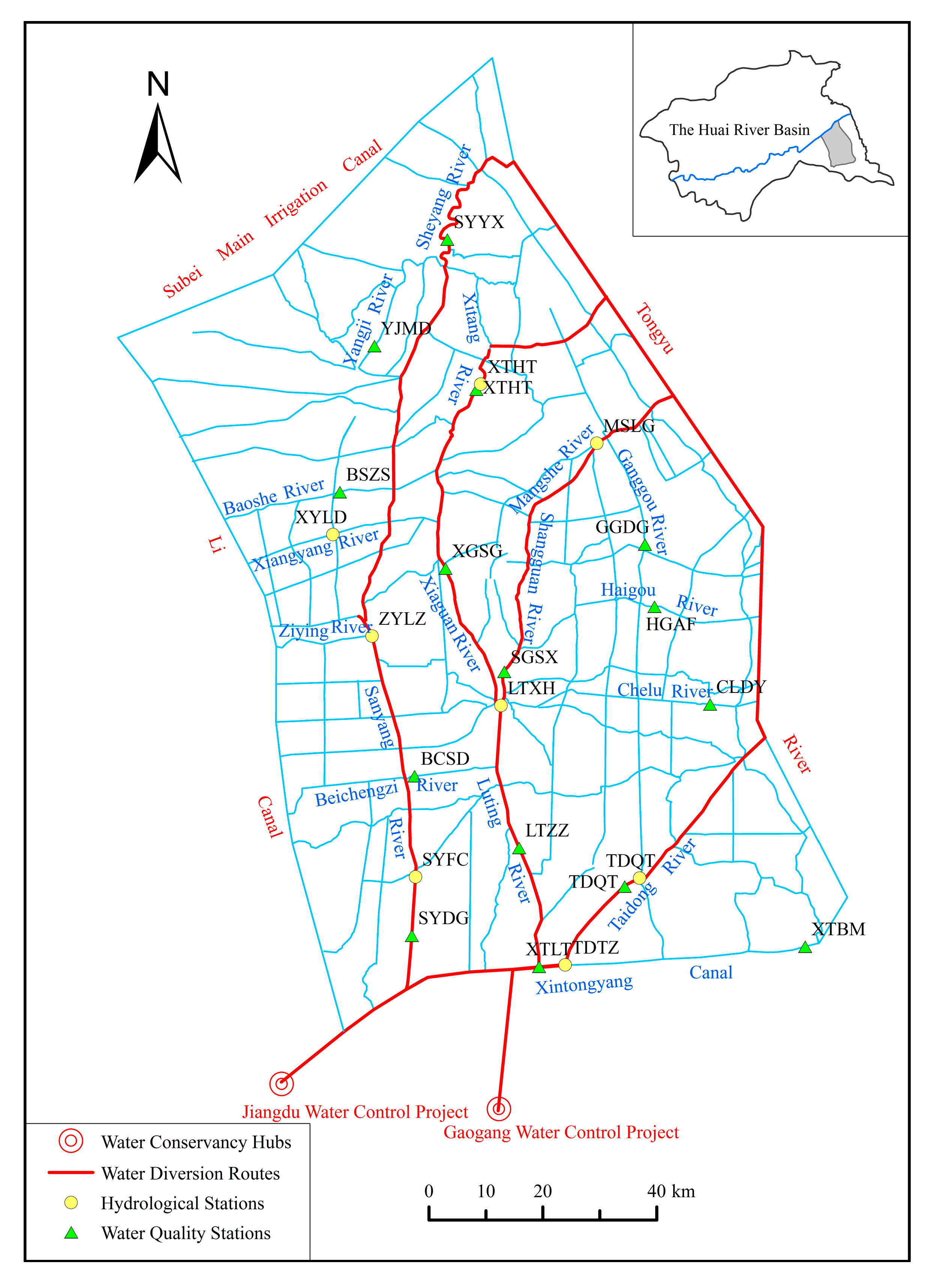

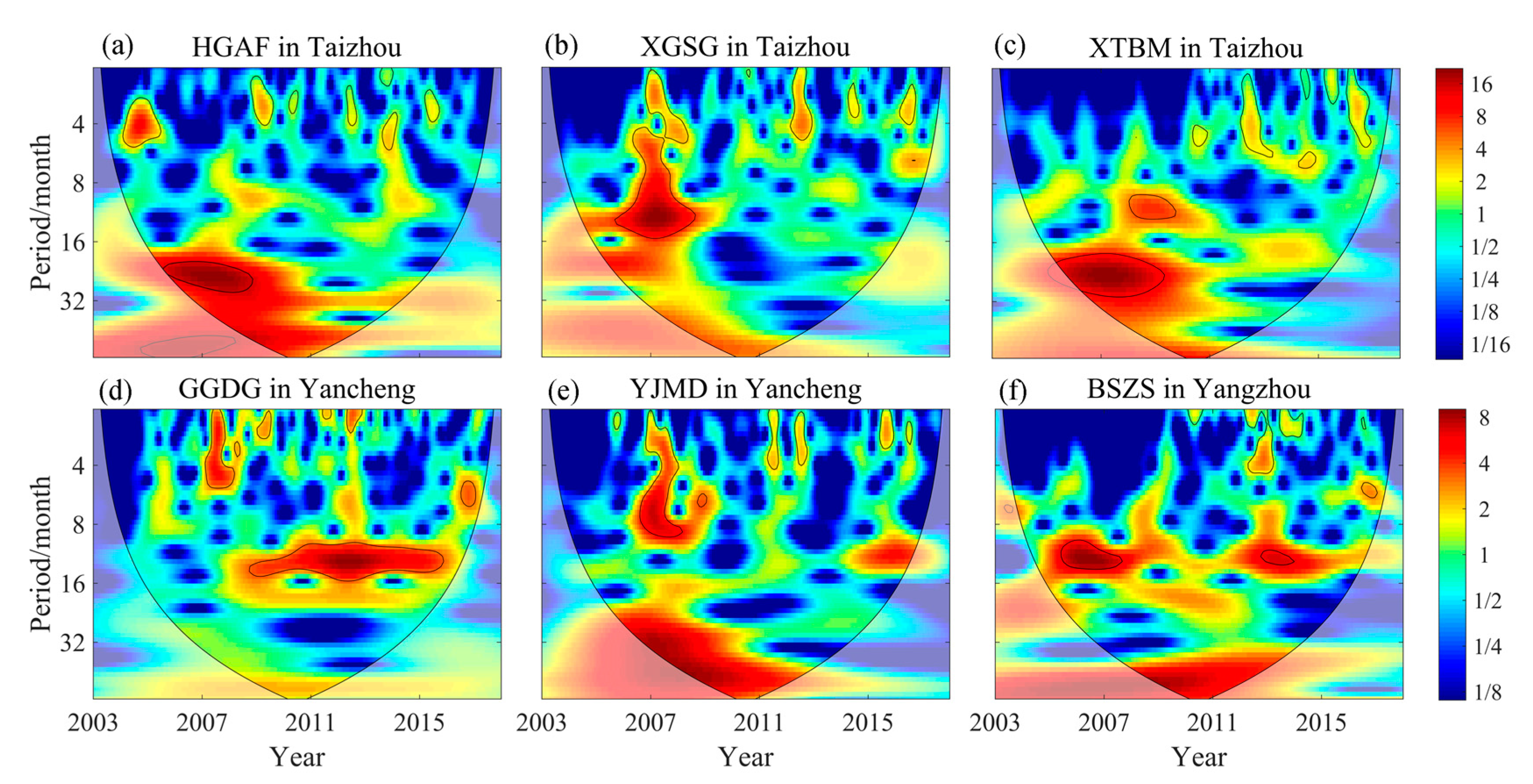
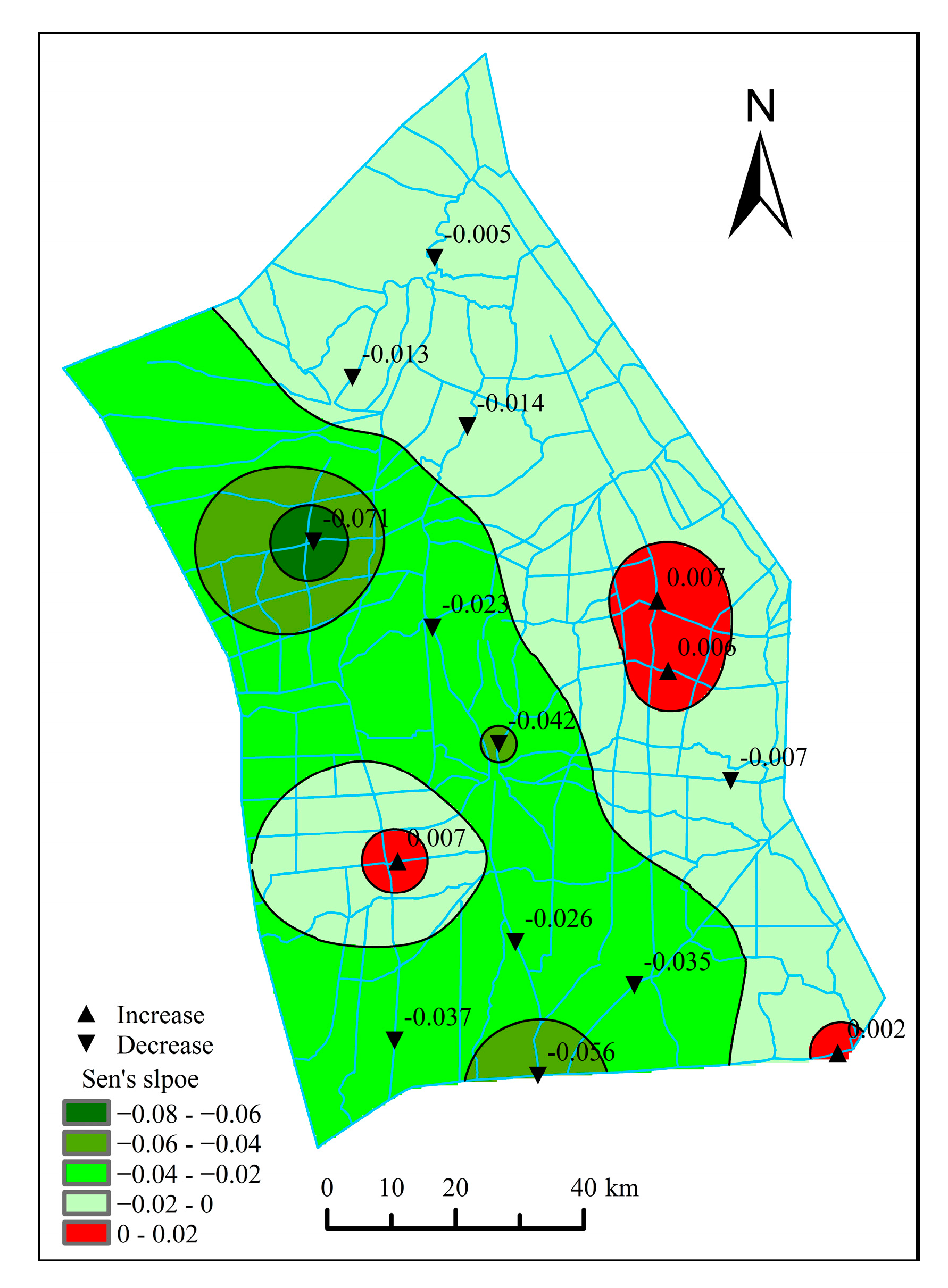
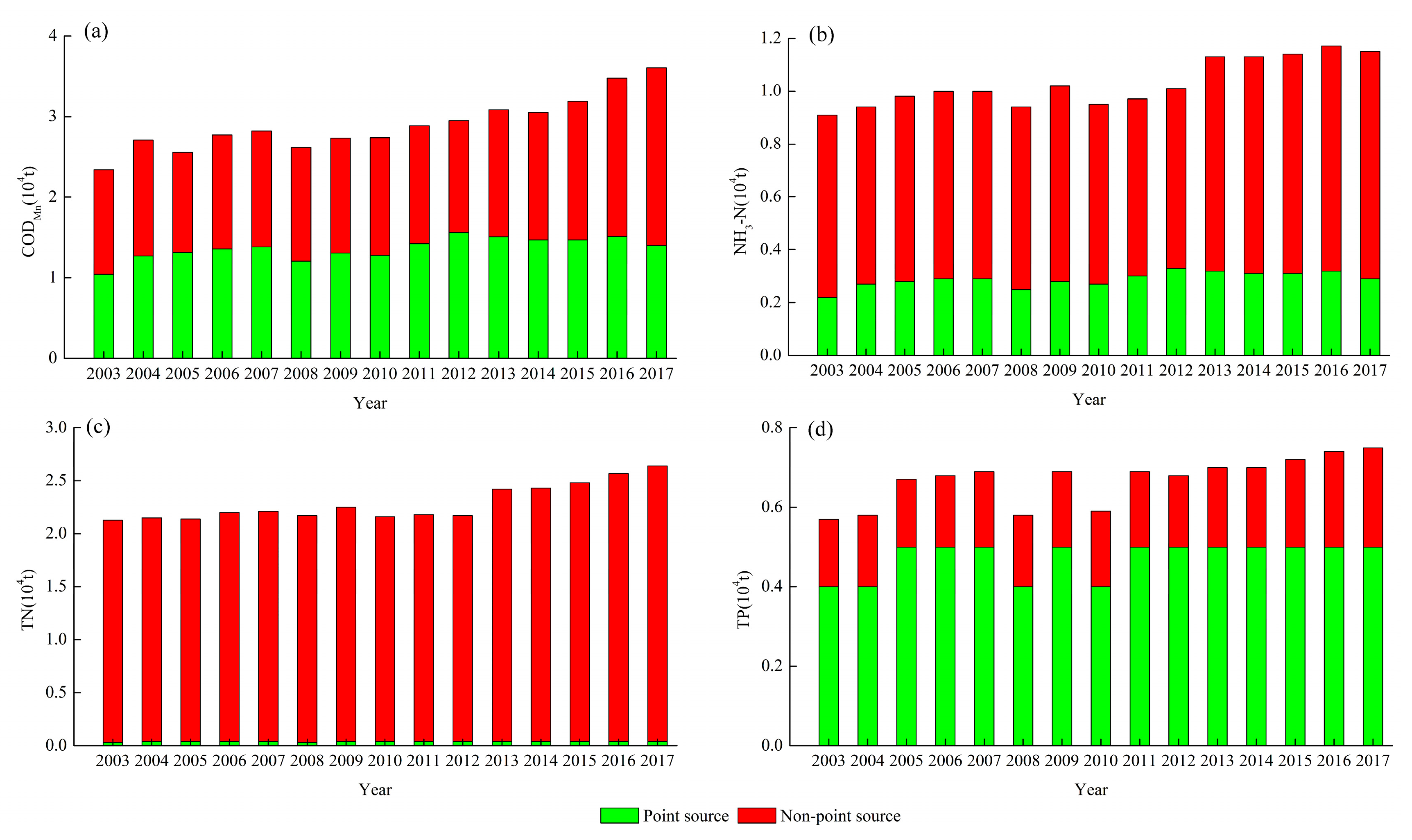
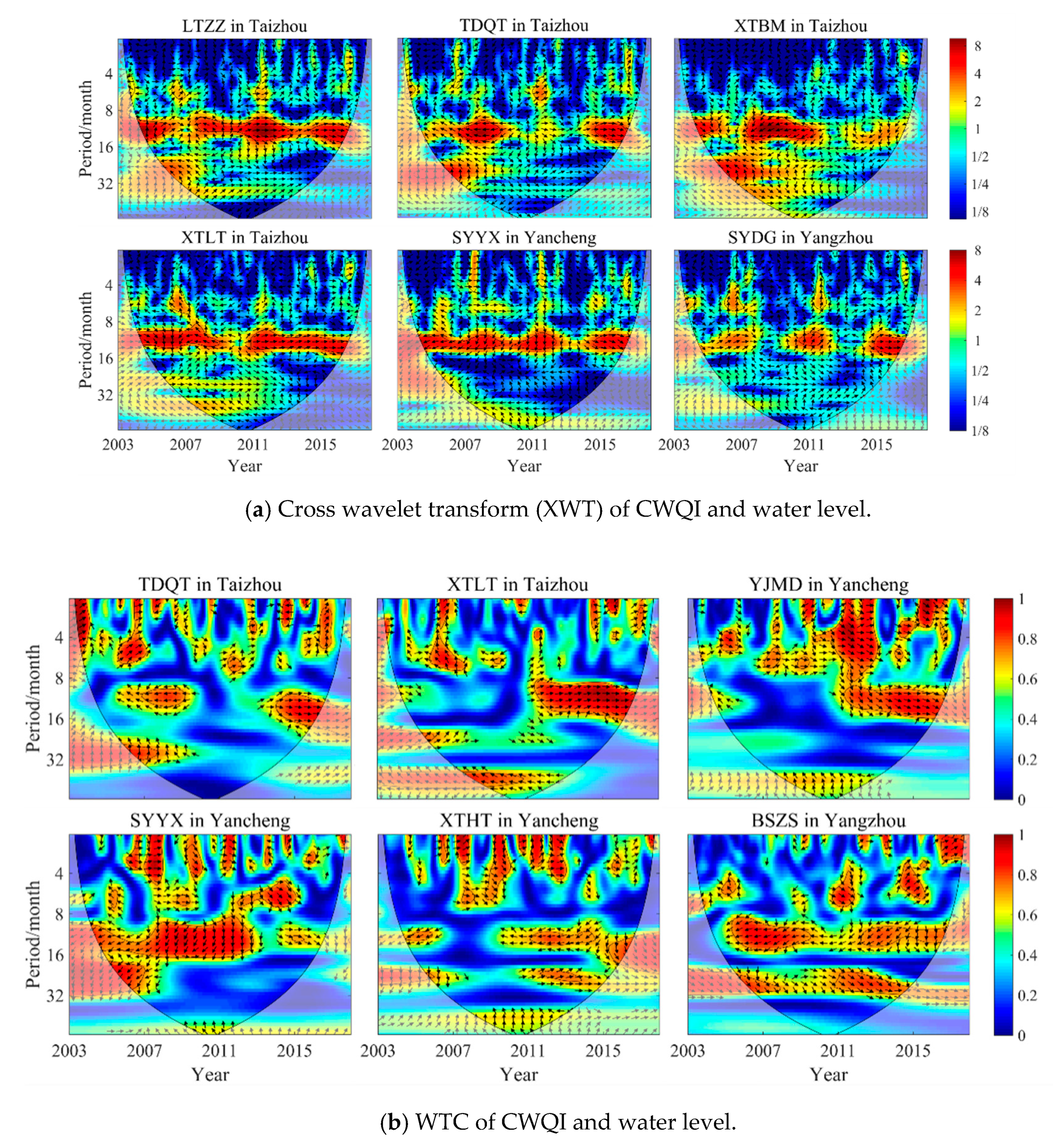

| Region | Monitoring Stations | High-Energy Area | Low-Energy Area | |||||
|---|---|---|---|---|---|---|---|---|
| Resonance Period (Month) | Time | Phase Relationship | Resonance Period (Month) | Time | Phase Relationship | Correlation Coefficient | ||
| Taizhou | CLDY | 10–14 | 2009–2013 | → | 4–7 | 2005–2007 | ↑ | 0.8 |
| 10–14 | 2013–2016 | → | 8–16 | 2010–2015 | → | 0.8 | ||
| HGAF | 11–13 | 2008 | ← | 1–4 | 2016–2017 | ↑ | 0.9 | |
| LTZZ | 10–14 | 2004–2006 | ↑ | 4–7 | 2006–2007 | → | 0.8 | |
| 9–15 | 2007–2013 | → | 39–50 | 2007–2012 | → | 0.7 | ||
| 11–14 | 2014–2016 | → | 8–20 | 2011–2016 | → | 0.9 | ||
| SGSX | 10–14 | 2007–2011 | ← | 2–6 | 2011 | → | 0.8 | |
| - | - | - | 10–14 | 2012–2015 | → | 0.7 | ||
| TDQT | 10–15 | 2006–2009 | ← | 10–13 | 2007–2009 | ← | 0.7 | |
| 11–15 | 2014–2016 | → | 27–32 | 2005–2007 | ↑ | 0.8 | ||
| - | - | - | 12–26 | 2013–2016 | → | 0.9 | ||
| XGSG | 9–16 | 2004–2009 | ← | 10–16 | 2005–2009 | ← | 0.8 | |
| - | - | - | 43–57 | 2007–2009 | ← | 0.7 | ||
| XTBM | 10–13 | 2004–2005 | → | 8–16 | 2008–2010 | ← | 0.8 | |
| 9–15 | 2007–2011 | → | - | - | - | - | ||
| XTLT | 9–14 | 2004–2008 | ↓ | 40–52 | 2007–2010 | ← | 0.7 | |
| 10–15 | 2010–2016 | → | 8–16 | 2011–2016 | → | 0.9 | ||
| Yancheng | GGDG | 10–15 | 2009–2013 | → | 2–8 | 2004–2006 | → | 0.9 |
| 12–14 | 2013–2016 | → | 8–14 | 2008–2013 | → | 0.8 | ||
| SYYX | 11–15 | 2004–2009 | ← | 20–30 | 2005–2006 | ← | 0.8 | |
| 10–15 | 2009–2012 | ↓ | 9–18 | 2004–2012 | ← | 0.9 | ||
| 11–14 | 2014–2016 | → | - | - | - | - | ||
| XTHT | 11–14 | 2004–2006 | ← | 12–13 | 2004–2005 | ← | 0.7 | |
| 12–14 | 2008–2010 | ← | 12–14 | 2011–2014 | ← | 0.7 | ||
| - | - | - | 12–20 | 2015–2016 | ↓ | 0.8 | ||
| YJMD | 12–14 | 2014–2016 | → | 1–9 | 2009–2012 | → | 0.9 | |
| - | - | - | 10–16 | 2011–2016 | → | 0.8 | ||
| Yangzhou | BSZS | 9–15 | 2004–2009 | ← | 8–15 | 2005–2009 | ← | 0.9 |
| 11–14 | 2011–2015 | ← | 21–31 | 2011–2014 | → | 0.8 | ||
| - | - | - | 11–14 | 2012–2016 | ← | 0.8 | ||
| BCSD | 9–15 | 2004–2010 | ← | 9–16 | 2004–2012 | ← | 0.9 | |
| SYDG | 11–13 | 2010–2011 | → | 1–6 | 2005–2007 | ↑ | 0.9 | |
| 12–15 | 2014–2016 | → | 12–15 | 2015–2016 | → | 0.8 | ||
| Indicator | Range Values (mg/L) | |||||
|---|---|---|---|---|---|---|
| Grade I | Grade II | Grade III | Grade IV | Grade V | Inferior to Grade V | |
| CODMn | [0, 2) | [2, 4) | [4, 6) | [6, 10) | [10, 15) | [15, infinity) |
| NH3-N | [0, 0.15) | [0.15, 0.5) | [0.5, 1) | [1, 1.5) | [1.5, 2) | [2, infinity) |
| SWQI/CWQI | [1, 2) | [2, 3) | [3, 4) | [4, 5) | [5, 6) | [6, infinity) |
| Description | Extremely good | Very good | Good | Poor | Very poor | Extremely poor |
| Indicator | Zs Value | Trend Slope | Tendency | Significance |
|---|---|---|---|---|
| CODMn | −0.693 | −0.015 | Decrease | Not significant |
| NH3-N | −3.068 | −0.01 | Decrease | Significant |
| CWQI | −1.98 | −0.013 | Decrease | Significant |
| Month | January | February | March | April | May | June | July | August | September | October | November | December | Mean | Standard Deviation |
|---|---|---|---|---|---|---|---|---|---|---|---|---|---|---|
| CODMn (mg/L) | 4.9 | 4.8 | 4.8 | 4.5 | 4.0 | 4.1 | 5.6 | 5.2 | 5.0 | 4.6 | 4.5 | 4.4 | 4.7 | 0.68 |
| NH3-N (mg/L) | 0.80 | 0.85 | 0.77 | 0.69 | 0.59 | 0.54 | 1.04 | 0.64 | 0.52 | 0.55 | 0.62 | 0.61 | 0.68 | 0.24 |
| CWQI | 3.35 | 3.42 | 3.36 | 3.19 | 3.00 | 2.96 | 3.80 | 3.34 | 3.15 | 3.09 | 3.16 | 3.10 | 3.24 | 0.35 |
| Region | Monitoring Stations | CODMn (mg/L) | NH3-N (mg/L) | CWQI | ||||||||
|---|---|---|---|---|---|---|---|---|---|---|---|---|
| Max. | Min. | Mean | op Rate * (%) | Max. | Min. | Mean | op Rate * (%) | Max. | Min. | Mean | ||
| Taizhou | CLDY | 6.0 | 2.5 | 4.9 | 16 | 1.0 | 0.3 | 0.5 | 9 | 3.7 | 2.7 | 3.2 |
| HGAF | 6.1 | 1.8 | 5.1 | 18 | 1.0 | 0.2 | 0.5 | 7 | 3.8 | 1.8 | 3.2 | |
| LTZZ | 4.5 | 2.0 | 3.6 | 6 | 0.8 | 0.2 | 0.5 | 10 | 3.3 | 2.3 | 2.8 | |
| SGSX | 5.8 | 2.8 | 4.6 | 8 | 1.3 | 0.5 | 0.9 | 32 | 3.9 | 3.0 | 3.5 | |
| TDQT | 4.8 | 1.8 | 3.4 | 3 | 1.1 | 0.3 | 0.6 | 16 | 3.6 | 2.1 | 2.9 | |
| XGSG | 8.1 | 4.8 | 5.7 | 28 | 1.0 | 0.3 | 0.6 | 10 | 4.1 | 3.2 | 3.4 | |
| XTBM | 6.7 | 2.0 | 5.0 | 24 | 2.4 | 0.3 | 1.6 | 73 | 4.9 | 2.2 | 4.2 | |
| XTLT | 5.0 | 3.0 | 3.5 | 6 | 1.1 | 0.3 | 0.7 | 25 | 3.7 | 2.5 | 3.0 | |
| Yancheng | GGDG | 5.6 | 4.8 | 5.3 | 13 | 0.7 | 0.2 | 0.4 | 4 | 3.4 | 2.9 | 3.1 |
| SYYX | 5.2 | 4.4 | 4.7 | 4 | 0.4 | 0.1 | 0.3 | 2 | 3.0 | 2.5 | 2.8 | |
| XTHT | 9.3 | 4.5 | 5.2 | 17 | 0.7 | 0.3 | 0.4 | 2 | 3.9 | 2.8 | 3.1 | |
| YJMD | 5.4 | 3.6 | 4.4 | 5 | 1.4 | 0.1 | 0.3 | 7 | 3.9 | 2.1 | 2.7 | |
| Yangzhou | BSZS | 8.0 | 4.4 | 6.1 | 42 | 2.2 | 0.9 | 1.1 | 49 | 5.0 | 3.5 | 4.0 |
| BCSD | 7.4 | 4.2 | 5.0 | 18 | 1.9 | 1.0 | 1.4 | 62 | 4.6 | 3.6 | 4.0 | |
| SYDG | 6.5 | 2.9 | 3.9 | 8 | 0.7 | 0.2 | 0.5 | 7 | 3.6 | 2.3 | 2.8 | |
| Region | Monitoring Stations | Characteristic Periods | |||||
|---|---|---|---|---|---|---|---|
| Taizhou | CLDY | Time | 2010–2012 | 2012–2013 | 2015 | - | - |
| Period (month) | 10–13 | 2–5 | 2–4 | - | - | ||
| HGAF | Time | 2004–2005 | 2005–2008 | 2008–2009 | 2013–2014 | 2016 | |
| Period (month) | 2–6 | 21–30 | 2–4 | 4–6 | 2–4 | ||
| LTZZ | Time | 2005–2007 | 2010–2012 | 2012 | 2012–2013 | 2016–2017 | |
| Period (month) | 18–25 | 10–15 | 2–5 | 6–7 | 2–6 | ||
| SGSX | Time | 2007–2009 | 2008–2010 | 2012–2013 | 2016–2017 | - | |
| Period (month) | 5–7 | 9–14 | 6 | 2–8 | - | ||
| TDQT | Time | 2005–2008 | 2007–2008 | 2010–2011 | 2015 | 2016 | |
| Period (month) | 21–30 | 5–7 | 6–7 | 4–5 | 2–7 | ||
| XGSG | Time | 2005–2008 | 2006–2008 | 2012 | 2014 | 2016 | |
| Period (month) | 4–16 | 2–5 | 2–5 | 2–4 | 2–4 | ||
| XTBM | Time | 2005–2009 | 2007–2009 | 2012–2013 | 2014 | 2015–2016 | |
| Period (month) | 18–31 | 9–13 | 2–6 | 5–7 | 2–5 | ||
| XTLT | Time | 2005–2007 | 2013 | 2016 | - | - | |
| Period (month) | 2–8 | 2–3 | 2–4 | - | - | ||
| Yancheng | GGDG | Time | 2007–2008 | 2008–2015 | 2016–2017 | - | - |
| Period (month) | 2–6 | 10–16 | 6–7 | - | - | ||
| SYYX | Time | 2007 | 2008–2009 | 2015–2016 | 2016 | - | |
| Period (month) | 2–5 | 6–7 | 9–14 | 4–6 | - | ||
| XTHT | Time | 2006–2008 | 2012 | 2015–2016 | - | - | |
| Period (month) | 30–36 | 2–4 | 2–5 | - | - | ||
| YJMD | Time | 2006–2007 | 2008 | 2011 | - | - | |
| Period (month) | 2–10 | 6–7 | 2–4 | - | - | ||
| Yangzhou | BSZS | Time | 2005–2007 | 2012–2013 | 2012–2013 | 2016 | - |
| Period (month) | 10–15 | 2–5 | 11–15 | 5–6 | - | ||
| BCSD | Time | 2003–2005 | 2007 | 2009–2010 | 2010–2012 | 2012–2013 | |
| Period (month) | 4–9 | 13 | 6–8 | 46–59 | 2–5 | ||
| SYDG | Time | 2003–2004 | 2005–2006 | 2007–2008 | 2011 | 2016 | |
| Period (month) | 6–7 | 4–7 | 6–7 | 7 | 2–6 | ||
| Region | Monitoring Stations | Zs Value | Annual Trend Slope | Tendency | Significance |
|---|---|---|---|---|---|
| Taizhou | CLDY | −0.897 | −0.007 | Decrease | Not significant |
| HGAF | 0.739 | 0.006 | Increase | Not significant | |
| LTZZ | −2.734 | −0.026 | Decrease | Significant | |
| SGSX | −4.267 | −0.042 | Decrease | Significant | |
| TDQT | −2.985 | −0.035 | Decrease | Significant | |
| XGSG | −3.144 | −0.023 | Decrease | Significant | |
| XTBM | 0.170 | 0.002 | Increase | Not significant | |
| XTLT | −4.015 | −0.056 | Decrease | Significant | |
| Yancheng | GGDG | 0.964 | 0.007 | Increase | Not significant |
| SYYX | −0.685 | −0.005 | Decrease | Not significant | |
| STHT | −1.851 | −0.014 | Decrease | Not significant | |
| YJMD | −1.549 | −0.013 | Decrease | Not significant | |
| Yangzhou | BSZS | −6.245 | −0.071 | Decrease | Significant |
| BCSD | 0.510 | 0.007 | Increase | Not significant | |
| SYDG | −2.854 | −0.037 | Decrease | Significant |
| Region | Monitoring Stations | High-Energy Area | Low-Energy Area | |||||
|---|---|---|---|---|---|---|---|---|
| Resonance Period (Month) | Time | Phase Relationship | Resonance Period (Month) | Time | Phase Relationship | Correlation Coefficient | ||
| Taizhou | CLDY | 10–14 | 2009–2013 | → | 4–7 | 2005–2007 | ↑ | 0.8 |
| 10–14 | 2013–2016 | → | 8–16 | 2010–2015 | → | 0.8 | ||
| HGAF | 11–13 | 2008 | ← | 1–4 | 2016–2017 | ↑ | 0.9 | |
| LTZZ | 10–14 | 2004–2006 | ↑ | 4–7 | 2006–2007 | → | 0.8 | |
| 9–15 | 2007–2013 | → | 39–50 | 2007–2012 | → | 0.7 | ||
| 11–14 | 2014–2016 | → | 8–20 | 2011–2016 | → | 0.9 | ||
| SGSX | 10–14 | 2007–2011 | ← | 2–6 | 2011 | → | 0.8 | |
| - | - | - | 10–14 | 2012–2015 | → | 0.7 | ||
| TDQT | 10–15 | 2006–2009 | ← | 10–13 | 2007–2009 | ← | 0.7 | |
| 11–15 | 2014–2016 | → | 27–32 | 2005–2007 | ↑ | 0.8 | ||
| - | - | - | 12–26 | 2013–2016 | → | 0.9 | ||
| XGSG | 9–16 | 2004–2009 | ← | 10–16 | 2005–2009 | ← | 0.8 | |
| - | - | - | 43–57 | 2007–2009 | ← | 0.7 | ||
| XTBM | 10–13 | 2004–2005 | → | 8–16 | 2008–2010 | ← | 0.8 | |
| 9–15 | 2007–2011 | → | - | - | - | - | ||
| XTLT | 9–14 | 2004–2008 | ↓ | 40–52 | 2007–2010 | ← | 0.7 | |
| 10–15 | 2010–2016 | → | 8–16 | 2011–2016 | → | 0.9 | ||
| Yancheng | GGDG | 10–15 | 2009–2013 | → | 2–8 | 2004–2006 | → | 0.9 |
| 12–14 | 2013–2016 | → | 8–14 | 2008–2013 | → | 0.8 | ||
| SYYX | 11–15 | 2004–2009 | ← | 20–30 | 2005–2006 | ← | 0.8 | |
| 10–15 | 2009–2012 | ↓ | 9–18 | 2004–2012 | ← | 0.9 | ||
| 11–14 | 2014–2016 | → | - | - | - | - | ||
| XTHT | 11–14 | 2004–2006 | ← | 12–13 | 2004–2005 | ← | 0.7 | |
| 12–14 | 2008–2010 | ← | 12–14 | 2011–2014 | ← | 0.7 | ||
| - | - | - | 12–20 | 2015–2016 | ↓ | 0.8 | ||
| YJMD | 12–14 | 2014–2016 | → | 1–9 | 2009–2012 | → | 0.9 | |
| - | - | - | 10–16 | 2011–2016 | → | 0.8 | ||
| Yangzhou | BSZS | 9–15 | 2004–2009 | ← | 8–15 | 2005–2009 | ← | 0.9 |
| 11–14 | 2011–2015 | ← | 21–31 | 2011–2014 | → | 0.8 | ||
| - | - | - | 11–14 | 2012–2016 | ← | 0.8 | ||
| BCSD | 9–15 | 2004–2010 | ← | 9–16 | 2004–2012 | ← | 0.9 | |
| SYDG | 11–13 | 2010–2011 | → | 1–6 | 2005–2007 | ↑ | 0.9 | |
| 12–15 | 2014–2016 | → | 12–15 | 2015–2016 | → | 0.8 | ||
| Region | Monitoring Stations | High-Energy Region | Low-Energy Region | |||||
|---|---|---|---|---|---|---|---|---|
| Resonance Period (Month) | Time | Phase Relationship | Resonance Period (Month) | Time | Phase Relationship | Correlation Coefficient | ||
| Taizhou | CLDY | 10–13 | 2013–2015 | ← | 1–7 | 2004–2007 | ← | 0.9 |
| - | - | - | 8–16 | 2011–2015 | ← | 0.8 | ||
| HGAF | 5–7 | 2013–2014 | ↑ | 8–16 | 2012–2015 | ← | 0.8 | |
| LTZZ | 12–14 | 2011–2012 | ← | 3–7 | 2005–2008 | ← | 0.9 | |
| 11–15 | 2015–2016 | ← | 5–8 | 2009–2013 | ← | 0.9 | ||
| - | - | - | 11–32 | 2014–2016 | ← | 0.8 | ||
| - | - | - | 2–7 | 2015–2016 | ← | 0.8 | ||
| SGSX | 11–14 | 2008–2010 | ↓ | 4–7 | 2007–2011 | ← | 0.9 | |
| - | - | - | 11–15 | 2008–2010 | ↓ | 0.7 | ||
| - | - | - | 11–25 | 2012–2016 | ← | 0.9 | ||
| TDQT | 12–13 | 2007–2008 | ↓ | 4-8 | 2005–2007 | ← | 0.9 | |
| 2–7 | 2014–2016 | ← | 4–31 | 2007–2016 | ← | 0.9 | ||
| 12–14 | 2015–2016 | ← | - | - | - | - | ||
| XGSG | 10–15 | 2005–2008 | ↓ | 10–16 | 2004–2008 | ↓ | 0.8 | |
| XTBM | 10–13 | 2007–2009 | → | 9–14 | 2008–2011 | → | 0.9 | |
| - | - | - | 4–8 | 2013–2016 | ← | 0.8 | ||
| XTLT | 4–7 | 2005–2007 | ← | 1–8 | 2004–2013 | ← | 0.9 | |
| 11–12 | 2005–2007 | → | 10–18 | 2012–2016 | ← | 0.9 | ||
| 12–15 | 2015–2016 | ← | - | - | - | - | ||
| Yancheng | GGDG | 11–16 | 2008–2016 | ← | 10–16 | 2010–2014 | ↑ | 0.8 |
| - | - | - | 18–27 | 2005–2012 | ← | 0.9 | ||
| SYYX | 11-14 | 2014–2016 | ← | 5–8 | 2007–2009 | ← | 0.9 | |
| - | - | - | 10–14 | 2007–2009 | → | 0.8 | ||
| - | - | - | 5–8 | 2013–2014 | ← | 0.9 | ||
| XTHT | 12–14 | 2009–2010 | → | 11–14 | 2004–2005 | → | 0.8 | |
| - | - | - | 11–16 | 2009–2011 | → | 0.7 | ||
| - | - | - | 10–13 | 2013–2014 | → | 0.7 | ||
| YJMD | 12–14 | 2014–2016 | ← | 4–7 | 2008–2010 | ← | 0.9 | |
| - | - | - | 9–15 | 2012–2016 | ← | 0.8 | ||
| Yangzhou | BSZS | 11–14 | 2005–2008 | → | 10–16 | 2004–2009 | → | 0.9 |
| 12–14 | 2012–2014 | → | 12–16 | 2012–2013 | → | 0.7 | ||
| BCSD | 4–8 | 2004–2006 | ← | 1–15 | 2003–2007 | ← | 0.9 | |
| 12–14 | 2005–2008 | ↓ | 12–14 | 2010–2012 | → | 0.7 | ||
| SYDG | 4–7 | 2005–2007 | ← | 1–8 | 2004–2009 | ← | 0.9 | |
| 2–7 | 2014–2016 | ← | 2–8 | 2010–2014 | ← | 0.9 | ||
| 12–15 | 2015–2016 | ← | 2–15 | 2014–2016 | ← | 0.8 | ||
© 2020 by the authors. Licensee MDPI, Basel, Switzerland. This article is an open access article distributed under the terms and conditions of the Creative Commons Attribution (CC BY) license (http://creativecommons.org/licenses/by/4.0/).
Share and Cite
Jiang, C.; Zhou, J.; Wang, J.; Fu, G.; Zhou, J. Characteristics and Causes of Long-Term Water Quality Variation in Lixiahe Abdominal Area, China. Water 2020, 12, 1694. https://doi.org/10.3390/w12061694
Jiang C, Zhou J, Wang J, Fu G, Zhou J. Characteristics and Causes of Long-Term Water Quality Variation in Lixiahe Abdominal Area, China. Water. 2020; 12(6):1694. https://doi.org/10.3390/w12061694
Chicago/Turabian StyleJiang, Chenjuan, Jia’nan Zhou, Jingcai Wang, Guosheng Fu, and Jiren Zhou. 2020. "Characteristics and Causes of Long-Term Water Quality Variation in Lixiahe Abdominal Area, China" Water 12, no. 6: 1694. https://doi.org/10.3390/w12061694
APA StyleJiang, C., Zhou, J., Wang, J., Fu, G., & Zhou, J. (2020). Characteristics and Causes of Long-Term Water Quality Variation in Lixiahe Abdominal Area, China. Water, 12(6), 1694. https://doi.org/10.3390/w12061694





